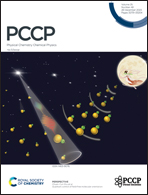Correlation of solute diffusion with dynamic viscosity in lithium salt-added (choline chloride + glycerol) deep eutectic solvents†
Abstract
Due to their favorable physicochemical properties, deep eutectic solvents (DESs) are finding increased use in chemistry. Metal salt-added DESs are currently being investigated for their potential applications in electrochemistry as a replacement for organic electrolytes. Insights into solute diffusion in salt-added DESs, in this context, are of the utmost importance. Solute diffusion in a LiCl-added DES composed of the H-bond acceptor choline chloride and the H-bond donor glycerol in a 1 : 2 mole ratio, named glyceline, is assessed as a function of temperature and LiCl concentration. For relative translational diffusion, the fluorophore–quencher pair of pyrene–nitromethane is used, whereas for rotational diffusion a fluorescent anisotropic rotor, perylene, is selected. The fluorescence quenching of pyrene by nitromethane was found to be purely dynamic in nature. The estimated bimolecular quenching rate constant (kq) exhibits excellent adherence to the Stokes–Einstein relation, suggesting relative translational diffusion of the solute to be controlled by the dynamic viscosity of the LiCl-added glyceline solution. The rotational reorientation time (θ) of the rotor perylene is also found to scale with dynamic viscosity and obey the Stokes–Einstein relation satisfactorily. Linear correlation between θ and dynamic viscosity (η) improves for glyceline solutions with fixed LiCl concentrations hinting at the possible change in the hydrodynamic volume with LiCl concentration within the DES. Control of rotational diffusion of the solute by the dynamic viscosity is established nonetheless. The effect of earlier reported micro- and/or nano-heterogeneities within salt-added DES systems on solute diffusion dynamics is found to be minimal. The work highlights DESs in offering a solubilizing medium for solutes where the diffusion dynamics are simply controlled by the dynamic viscosity.



 Please wait while we load your content...
Please wait while we load your content...